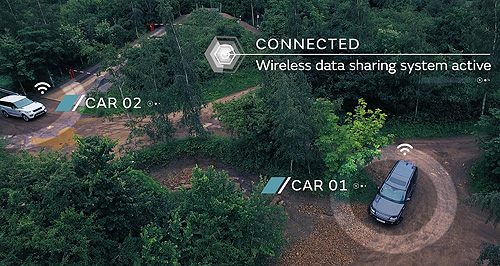News - Land RoverJLR takes autonomy testing off roadFuture now: The technology JLR is detailing will ensure vehicles can go off road in autonomous mode in the future. Jaguar Land Rover details its latest autonomous all-terrain adventure13 Jul 2016 JAGUAR Land Rover will test on and off-road autonomous functionality and cars that converse with each other as part of its plans to create a fleet of more than 100 research vehicles over the next four years. The Indian-owned British company is developing connected and autonomous vehicle functions, headlined by an off-road system tested on the Land Rover test tracks at the factory as well as a 66km test route on motorways and suburban roads adjacent the brands’ Coventry and Solihull manufacturing facilities later this year. While a number of brands are involved in ongoing car-to-car research, JLR has developed off-road technology that allows autonomous vehicles to traverse almost any terrain using ultrasonic sensors to assess the surface and surroundings five metres in front of the car. The system can identify grass, gravel, sand and snow and is able to adapt the vehicle speed to rough terrain or water, as well as talking to JLR’s existing Terrain Response system to select the appropriate mode. The multi-million dollar autonomous all-terrain driving research project is aiming to make the self-driving car viable in a wide range of terrain and conditions. Jaguar Land Rover head of research Tony Harper said the company did not want to limit future highly automated and fully autonomous technologies to tarmac. “In the future, if you enjoy the benefits of autonomous lane keeping on a motorway at the start of your journey, we want to ensure you can use this all the way to your destination, even if this is via a rough track or gravel road,” he said. “This advanced capability would be available to both the driver and the autonomous car, with the driver able to let the car take control if they were unsure how best to tackle an obstacle or hazard ahead.” Combining camera, ultrasonic, radar and Light Imaging, Detection, And Ranging (LIDAR) sensors, the car takes a 360 degree view if its position, as well as using advanced sensors to determine surface characteristics to plan its route. Mr Harper said the car is being given the ability to sense, predict and take its own 3D path. “This means being able to scan and analyse both the surface to be driven on, as well as any hazards above and to the sides of the path ahead. This might include car park barriers, tree roots and boulders or overhanging branches, as well as the materials and topography to be driven on,” he said. JLR’s research has also resulted in the vehicles’ ability to communicate – useful when out of sight around a bend or on the other side of an off-road obstacle – demonstrated using two connected Range Rover Sports sharing information including vehicle location, system settings, wheel-slip, changes to suspension height and wheel articulation. Jaguar Land Rover Australia senior public relations executive James Scrimshaw said the off-road functions were being tested on the company’s existing 4WD test tracks and the off-road course at Eastnor Castle. “There’s no time-frame on when we might see it here, but this is something that we could introduce because we’re not going to have the same restrictions as autonomous vehicles on the road, so there’s not going to be the same legislation holding us back for using that in an off-road situation,” he said. The road-going uses for the technology are also being investigated by JLR, which is testing communications between vehicles as well as vehicle-to-infrastructure communication technologies. The company’s long-term aim of data sharing between vehicles would allow future connected cars to co-operate, help improve traffic flow, cut congestion and reduce the potential for accidents. “We will also improve the driving experience, with drivers able to choose how much support and assistance they need. In traffic, for example, the driver could choose autonomy assist during tedious or stressful parts of the journey,” Mr Harper said. The brand is mindful of its sporting heritage – rather than concentrating only on convoy procedures or negotiating roadworks autonomously (which is part of the program), the research has also taken the enthusiast into consideration, warning of unseen hazards on the road ahead over blind crests or corners, or the presence of emergency services. ‘Emergency Vehicle Warning’ allows connected ambulances, police cars or fire engines to communicate with other vehicles on the road, broadcasting its approach before lights and sirens have been able to alert the driver to safely pull over and allow emergency vehicles to pass without delay.  Read more19th of May 2016  Britain aims to become leader in driverless carsNew legislation aims to bolster UK drive to become leader in autonomous vehicles8th of February 2016  Autonomy trumped by flesh and blood: JLRJaguar Land Rover puts driving involvement before self-driving technology |
Click to shareLand Rover articlesResearch Land Rover Motor industry news |























Facebook Twitter Instagram